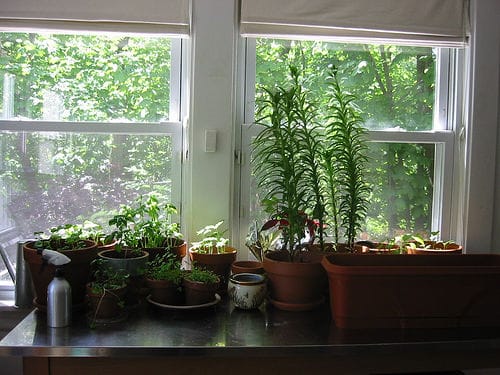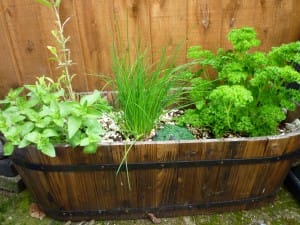Source(s): Wayne McLaurin, Professor Emeritus of Horticulture, The University of Georgia, College of Agricultural and Environmental Sciences
Herbs aren’t just for the garden; many are attractive in perennial borders or even among foundation plantings. Pots of herbs add to the appearance of a porch or patio. They can provide traditional materials for landscaping that are both useful and ornamental.
Herbs offer bloom, color variation or texture in beds or perennial gardens. In early summer, yarrows lift dense flower heads while, in fall, pineapple sage displays showy, bright red inflorescence. Lavenders, artemisias, and lamb’s ears proffer gray-green or white mounds of foliage much of the year.
Herbs, such as germander, santolina, winter savory and chives can be used effectively as edging plants; various thymes (including woolly, creeping, and lemon thyme) are both fragrant and attractive growing between stones in the patio or sidewalk, or in niches in a retaining wall.
As with other landscaping plants, select herbs according to their foliage colors, size, cultivation needs and growth habits.
Herb Size
- Tall/large herbs — anise, hyssop, yarrow, lemon verbena, fennel, mountain mint, bay
- Medium/upright or mounding — basil, sage, lavender, artemisia, scented geranium
- Small/upright or prostrate — thyme, stachys, germander, santolina
Container Plantings
Herbs grow well in urns, hanging baskets, strawberry pots, and other containers as long as the light, moisture, and fertility requirements are met. Use a good lightweight, well-drained artificial soil mix, not garden soil, for container-grown herbs. Container-grown herbs do not have access to surrounding soils, are more likely to dry out quickly, and must be watered regularly, even daily. Containers should have drainage holes so excess water can escape. Regularly empty any water in the saucers under containers to prevent roots from deteriorating. Uniform monthly fertilizing keeps herbs lush, but be careful to avoid fertilizer salts build-up. Water containers sufficiently so the water runs through the holes in the bottom of the container.
Note: Some herbs — French tarragon, chervil, cilantro, cumin, and chamomile — are particularly susceptible to humid southern springs and summers and may grow best in containers under more carefully controlled conditions.
Indoor Plantings
Herbs can be grown indoors if the right amounts of sun and moisture are provided. Herbs need to receive at least four to six hours of sunlight each day. Do not assume that herbs near windows automatically receive enough light for growth. An average south-facing window should provide adequate light. Herbs will grow tall and spindly in inadequate light. Rotate the plants periodically so that all sides receive enough light and pinch them back to promote bushiness. Plants grown indoors will generally not grow as fast as those grown outdoors and there will not be as many leaves to harvest.
Herbs such as scented geraniums, patchouli, and bay are sensitive to cold temperatures; if they are planted in containers, they can be easily moved indoors during cooler weather.
Water herbs only when they are dry. If the soil feels at all moist 1 inch below the surface, do not water the plant. Over-watering increases the chance of disease and may eventually block necessary oxygen to the roots.
Resource(s): Herbs in Southern Gardens
Center Publication Number: 262
- Growing Herbs - September 24, 2013
- Harvesting and Preserving Herbs - September 24, 2013
- Herbs in the Landscape - September 24, 2013
